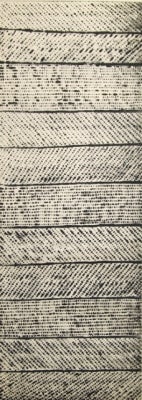
Kayimwagakimi jilamara I
Etching, sugarlift & aquatint 68.5 x 24.8 cm Numbered 39/40 Kayimwagakimi is the traditional Tiwi painting 'comb'. Made from bloodwood or ironwood, it is about 15cm high with a single row of teeth. The comb is dabbed in ochre and applied to the painting surface resulting in a straight line of fine dots, a process which is repeated over and over. Kayimwagakimi and marlipinyini (a fine stick or pandanus frond chewed to form a brush) have largely been replaced by modern brushes but a handful of Tiwi still use traditional tools. (Jilamara Arts and Craft, August 2006) Notes: Raelene was born on 1 September, 1962, on Bathurst Island and raised by her grandmother. Her older brother Vivian is also a painter. Raelene began designing screens for fabric printing in 1985 as part of the adult education program in Milikapiti, and then took up painting with the establishing of Jilamara Arts and Craft in 1989. Initially, Raelene used brushes with ochres but since 1999 she has adopted the traditional painting technique of using a comb (kayimwagakini). Combs were used primarily used in the past for ceremonial body painting applications, and are typically made from bloodwood or ironwood. Raelene was inspired to incorporate the traditional technique of the kayimwagakini after observing Pedro Wonaeamirri using it, and viewing older pole carvings in the National Museum by the late Tiwi carver, Sugarbag Kapiti. The making of the comb is a skill in itself, and Raelene's partner James Tipiloura, a carver with Jilamara Arts and Craft, carves the combes for Raelene's work. In addition to printmaking, Raelene works with ochres on paper, bark, and canvas, and her work has been acquired for major public and private art collections including at the National Gallery of Australia. Raelene has participated in group exhibitions since 1991, and she has held several solo shows in Darwin and Sydney since 2004. (Jilamara Arts and Craft, July 2006)
Item #3141
Sold

